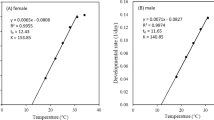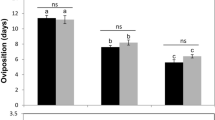Abstract
Development of the solitary parasitoidApanteles sp. groupultor in larvae ofEctomyelois ceratoniae was investigated at different constant temperatures. Temperature had a significant effect upon parasitoid development during both host-internal and host-external phases. The duration of the host-internal phase varied from 41 days at 15–17°C to 8.6 days at 29°C, the duration of the host-external phase varied from 16.5 days at 16–17°C to 5.4 days at 29°C.
Effect of photoperiod upon parasite development and parasitization of hosts were determined under daily photophases, of 24, 16, 12, 8 and 0 hours. No significant differences in oviposition rate were found among the 5 treatments. In any photoperiod studied, the parasite progeny developed normally without entering diapause.
Résumé
Le développement du parasitoïde solitaireApanteles sp. groupeultor à l'intérieur des larves d'Ectomyeloïs ceratoniae a été étudié à différentes températures constantes. La température a un effet significatif sur le développement du parasitoïde durant les phases endophages et ectophages. La durée de la phase endophage variait de 41 jours à 15–17°C à 8,6 jours à 29°C, la durée de la phase ectophage variait de 16,5 jours à 16–17°C à 5,4 jours à 29°C.
L'effet de la photopériode sur le développement du parasitoïde et sur l'attaque des hôtes a été déterminé aux photophases journalières de 24, 16, 12, 8 et 0 heure. Aucune différence significative du taux d'oviposition n'a été trouvée entre les 5 traitements. Dans chaque photopériode étudiée, la descendance du parasite se développait normalement sans manifester de diapause.
Similar content being viewed by others
References
Al-Izzi, M. A. J., Al-Maliky, S. K., Younis, M. A. &Jabbo, N. F.—1985. Bionomics ofEctomyelois ceratoniae [Lepidoptera: Pyralidae] on Pomegranates in Iraq.—Environ. Entomol., 14, 149–153.
Al-Izzi, M. A. J., Al-Maliky, S. K. &Jabbo, N. F.—1987. Culturing of the carob mothEctomyelois ceratoniae (Zeller) [Lepidoptera: Pyralidae] on an Artificial Diet.—J. Econ. Entomol., 80, 277–280.
Al-Maliky, S. K. &Al-Izzi, M. A. J.—1986. Parasites ofEctomyelois ceratoniae (Zeller) with biological studies onApanteles sp. groupultor in, Iraq.—Entomophaga, 31, 313–319.
Barbosa, P. &Frongillo, E. A. Jr.—1977. Influence of light intensity and temperature on the locomotoray and flight activity ofBrachymeria intermedia [Hym.: Chalcididae] a pupal parasitoid of the gypsy moth.—Entomophaga, 22, 405–411.
Butler, G. D. Jr., Hamilton, A. G. &Lopez, J. D. Jr.—1983.Cardiochiles nigricipes [Hym.: Braconidae]: Development time and fecundity in relation to temperature.—Ann. Entomol. Soc. Am., 76, 536–538.
Campbell, A., Frazer, B. D., Gilbert, N., Guiterrez, A. P. &Mackauer, M.—1974. Temperature requirements of some aphids and their parasites.—J. Anim. Ecol., 11, 431–438.
Cardona, C. &Oatman, E. R.—1975. Biology and physical ecology ofApanteles sublanchard Blanchard [Hym.: Braconidae], with notes on temperature responses ofApanteles scutellaris. Muesebeck and its host, the potato tuberworm.—Hilgardia, 43, 1–51.
Chiang, H. C. &Sisson, V.—1968. Temperature relationships of the development of northern corn rootworm eggs.—J. Econ. Entomol., 61, 1406–1410.
Dittrick, L. E. &Chiang, H. C.—1981. Developmental characteristic ofMacrocentrus grandii as influenced by temperature and instar of its host, the European corn borer.—J. Insect Physiol., 28, 47–72.
Eckenrode, C. J. &Chapman, R. K.—1971. Effect of various temperatures upon rate of development of the cabbage maggot under artificial conditions.—Ann. Entomol. Soc. Am., 64, 1074–1083.
Ito, Y., Miyashita, K. &Yamada, H.—1968. Biology ofHyphantria cunea Drury [Lepidoptera: Arctiidae] in Japan. VI. Effect of temperature on development of immature stages.—Appl. Entomol. Zool., 3, 163–175.
Madar, R. J. &Miller, J. C.—1983. Developmental biology ofApanteles gakutatensis [Hymenoptera: Braconidae], a primary parasite ofAutographa californica [Lepidoptera: Noctuidae].—Ann. Entomol Soc. Am., 76, 683–687.
Mohyuddin, A. I.—1971. Comparative biology and ecology ofApanteles flavipes (Cam.) andA. sesamiae Cam. as parasites of graminaceous borers.—Bull. Entomol. Res., 61, 33–39.
Osborne, L. S.—1982. Temperature-dependent development of greenhouse whitefly and its parasiteEncarsia formosa.—Environ. Entomol., 11, 483–485.
Powell, J. E., Shepard, M. &Sullivan, M. J.—1981. Use of heating degree day and physiological day equations for predicting development of the parasitoidTrissolcus basalis.—Environ. Entomol., 10, 1008–1011.
Rabb, R. L. &Thurston, R.—1969. Diapause inApanteles congregatus.—Ann. Entomol. Soc. Am., 62, 125–128.
Ryan, R. B., Mortensen, R. W. &Torgersen, T. R.—1981. Reproductive biology ofTelenomus californicus Ashmead, an egg parasite of the Douglas-fir Tussock Moth: Laboratory studies.—Ann. Entomol. Soc. Am., 74, 213–216.
Sanborn, S. M., Wyman, J. A. &Chapman, P. K.—1982. Threshold temperature and heat unit summations for seedcorn maggot development under controlled conditions.—Ann. Entomol. Soc. Am., 75, 103–106.
Schultz, P. B. &Kok, L. T.—1980. Physical factors affecting laboratory rearing of the pupal parasiteCoccygomimus turionellae.—Ann. Entomol. Soc. Am., 73, 522–525.
Stinner, R. E., Gutierrez, A. P. &Butler, G. D. Jr.—1974. An algorithm for temperature-dependent growth rate simulation.—Can. Entomol., 106, 519–524.
Thurston, R.—1976. Diapause inhibition inManduca sexta andApanteles congregatus by high scotophase temperatures.—Environ. Entomol., 5, 626–627.
Vinson, S. B., Guillot, F. S. &Hays, D. B.—1973. Rearing ofCardiochiles nigriceps of the laboratory, withHeliothis virescens as host.—Ann. Entomol. Soc. Am., 66, 1170–1172.
Author information
Authors and Affiliations
Rights and permissions
About this article
Cite this article
Al-Maliky, S.K., Al-Izzi, M.A.J. & Jabbo, N.F. Effects of temperature and photoperiod on the development and oviposition ofApanteles sp. groupUltor [Hym.: Braconidae], a larval parasite of the carob mothEctomyelois ceratoniae [Lep.: Pyralidae] . Entomophaga 33, 193–200 (1988). https://doi.org/10.1007/BF02372654
Received:
Accepted:
Issue Date:
DOI: https://doi.org/10.1007/BF02372654




